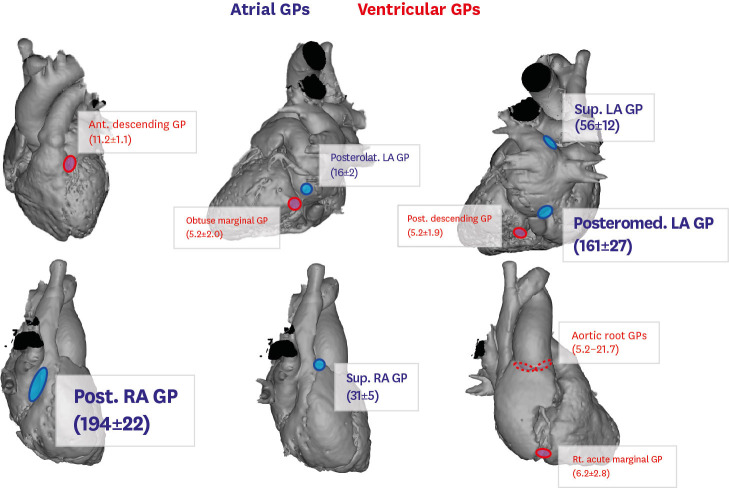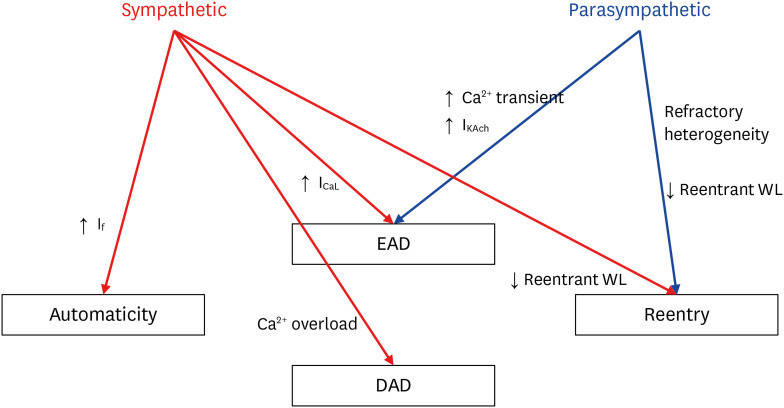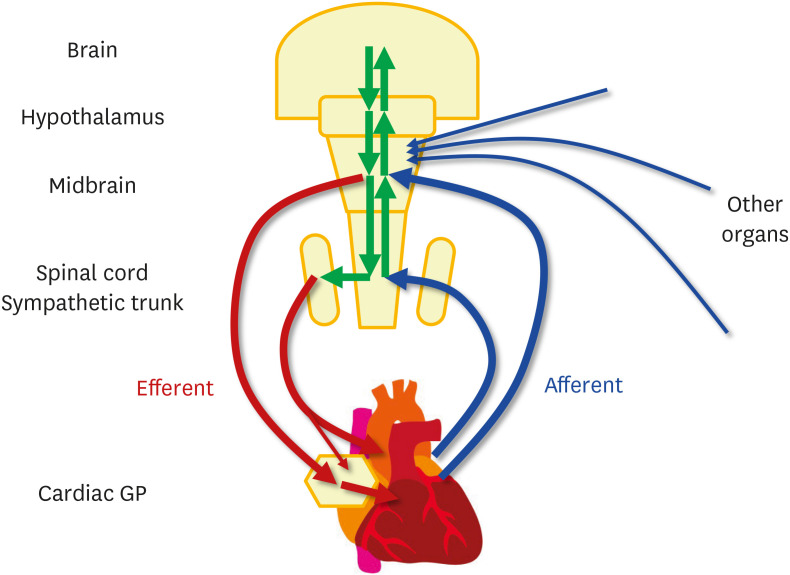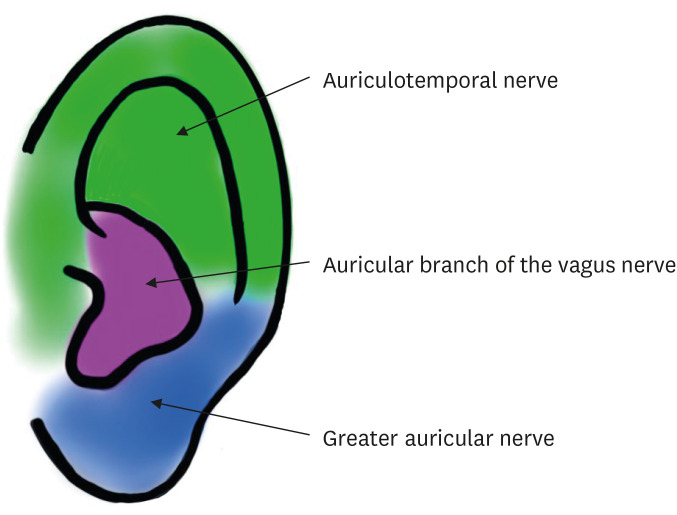Korean Circ J.
2024 May;54(5):223-232. 10.4070/kcj.2024.0050.
Neuromodulation for Atrial Fibrillation Control
- Affiliations
-
- 1Department of Internal Medicine, Seoul National University College of Medicine, Seoul, Korea
- KMID: 2556519
- DOI: http://doi.org/10.4070/kcj.2024.0050
Abstract
- Trigger and functional substrate are related to the tone of autonomic nervous system, and the role of the autonomic nerve is more significant in paroxysmal atrial fibrillation (AF) compared to non-paroxysmal AF. We have several options for neuromodulation to help to manage patients with AF. Neuromodulation targets can be divided into efferent and afferent pathways. On the efferent side, block would be an intuitive approach. However, permanent block is hard to achieve due to completeness of the procedure and reinnervation issues. Temporary block such as botulinum toxin injection into ganglionated plexi would be a possible option for post-cardiac surgery AF. Low-level subthreshold stimulation could also prevent AF, but the invasiveness of the procedure is the barrier for the general use. On the afferent side, block is also an option. Various renal denervation approaches are currently under investigation. Auditory vagus nerve stimulation is one of the representative low-level afferent stimulation methods. This technique is noninvasive and easy to apply, so it has the potential to be widely utilized if its efficacy is confirmed.
Figure
Reference
-
1. Kim D, Yang PS, Joung B. Optimal rhythm control strategy in patients with atrial fibrillation. Korean Circ J. 2022; 52:496–512. PMID: 35790494.2. Joglar JA, Chung MK, Armbruster AL, et al. 2023 ACC/AHA/ACCP/HRS guideline for the diagnosis and management of atrial fibrillation: a report of the American College of Cardiology/American Heart Association joint committee on clinical practice guidelines. Circulation. 2024; 149:e1–e156. PMID: 38033089.3. Janes RD, Brandys JC, Hopkins DA, Johnstone DE, Murphy DA, Armour JA. Anatomy of human extrinsic cardiac nerves and ganglia. Am J Cardiol. 1986; 57:299–309. PMID: 3946219.4. Pauza DH, Skripka V, Pauziene N, Stropus R. Morphology, distribution, and variability of the epicardiac neural ganglionated subplexuses in the human heart. Anat Rec. 2000; 259:353–382. PMID: 10903529.5. Chiou CW, Eble JN, Zipes DP. Efferent vagal innervation of the canine atria and sinus and atrioventricular nodes. The third fat pad. Circulation. 1997; 95:2573–2584. PMID: 9184589.6. Armour JA, Murphy DA, Yuan BX, Macdonald S, Hopkins DA. Gross and microscopic anatomy of the human intrinsic cardiac nervous system. Anat Rec. 1997; 247:289–298. PMID: 9026008.7. Marron K, Wharton J, Sheppard MN, et al. Distribution, morphology, and neurochemistry of endocardial and epicardial nerve terminal arborizations in the human heart. Circulation. 1995; 92:2343–2351. PMID: 7554220.8. Benarroch EE. The arterial baroreflex: functional organization and involvement in neurologic disease. Neurology. 2008; 71:1733–1738. PMID: 19015490.9. Hoover DB, Isaacs ER, Jacques F, Hoard JL, Pagé P, Armour JA. Localization of multiple neurotransmitters in surgically derived specimens of human atrial ganglia. Neuroscience. 2009; 164:1170–1179. PMID: 19747529.10. Tai CT, Chiou CW, Chen SA. Interaction between the autonomic nervous system and atrial tachyarrhythmias. J Cardiovasc Electrophysiol. 2002; 13:83–87. PMID: 11843490.11. Khan M, Kalahasti V, Rajagopal V, et al. Incidence of atrial fibrillation in heart transplant patients: long-term follow-up. J Cardiovasc Electrophysiol. 2006; 17:827–831. PMID: 16903960.12. Cohn WE, Gregoric ID, Radovancevic B, Wolf RK, Frazier OH. Atrial fibrillation after cardiac transplantation: experience in 498 consecutive cases. Ann Thorac Surg. 2008; 85:56–58. PMID: 18154778.13. Bettoni M, Zimmermann M. Autonomic tone variations before the onset of paroxysmal atrial fibrillation. Circulation. 2002; 105:2753–2759. PMID: 12057990.14. Lee SM, Choi EK, Chung GS, Oh S, Park KS. Quantification of cardiac autonomic nervous activities in ambulatory dogs by eliminating cardiac electric activities using cubic smoothing spline. Physiol Meas. 2012; 33:131–145. PMID: 22227824.15. Choi EK, Shen MJ, Han S, et al. Intrinsic cardiac nerve activity and paroxysmal atrial tachyarrhythmia in ambulatory dogs. Circulation. 2010; 121:2615–2623. PMID: 20529998.16. Schauerte P, Scherlag BJ, Pitha J, et al. Catheter ablation of cardiac autonomic nerves for prevention of vagal atrial fibrillation. Circulation. 2000; 102:2774–2780. PMID: 11094046.17. Melo J, Voigt P, Sonmez B, et al. Ventral cardiac denervation reduces the incidence of atrial fibrillation after coronary artery bypass grafting. J Thorac Cardiovasc Surg. 2004; 127:511–516. PMID: 14762362.18. Alex J, Guvendik L. Evaluation of ventral cardiac denervation as a prophylaxis against atrial fibrillation after coronary artery bypass grafting. Ann Thorac Surg. 2005; 79:517–520. PMID: 15680826.19. Cummings JE, Gill I, Akhrass R, Dery M, Biblo LA, Quan KJ. Preservation of the anterior fat pad paradoxically decreases the incidence of postoperative atrial fibrillation in humans. J Am Coll Cardiol. 2004; 43:994–1000. PMID: 15028356.20. Wu CC, Russell RM, Karten HJ. The transport rate of cholera toxin B subunit in the retinofugal pathways of the chick. Neuroscience. 1999; 92:665–676. PMID: 10408614.21. Conte WL, Kamishina H, Reep RL. The efficacy of the fluorescent conjugates of cholera toxin subunit B for multiple retrograde tract tracing in the central nervous system. Brain Struct Funct. 2009; 213:367–373. PMID: 19621243.22. Lee SR, Cho Y, Cha MJ, Choi EK, Seo JW, Oh S. Atrial innervation patterns of intrinsic cardiac autonomic nerves. J Korean Med Sci. 2018; 33:e253. PMID: 30250413.23. Oh S, Zhang Y, Bibevski S, Marrouche NF, Natale A, Mazgalev TN. Vagal denervation and atrial fibrillation inducibility: epicardial fat pad ablation does not have long-term effects. Heart Rhythm. 2006; 3:701–708. PMID: 16731474.24. Schwaiger M, Hutchins GD, Kalff V, et al. Evidence for regional catecholamine uptake and storage sites in the transplanted human heart by positron emission tomography. J Clin Invest. 1991; 87:1681–1690. PMID: 2022739.25. De Marco T, Dae M, Yuen-Green MS, et al. Iodine-123 metaiodobenzylguanidine scintigraphic assessment of the transplanted human heart: evidence for late reinnervation. J Am Coll Cardiol. 1995; 25:927–931. PMID: 7884099.26. Wilson RF, Christensen BV, Olivari MT, Simon A, White CW, Laxson DD. Evidence for structural sympathetic reinnervation after orthotopic cardiac transplantation in humans. Circulation. 1991; 83:1210–1220. PMID: 2013143.27. Kaye DM, Esler M, Kingwell B, McPherson G, Esmore D, Jennings G. Functional and neurochemical evidence for partial cardiac sympathetic reinnervation after cardiac transplantation in humans. Circulation. 1993; 88:1110–1118. PMID: 8353872.28. Stark RP, McGinn AL, Wilson RF. Chest pain in cardiac-transplant recipients. Evidence of sensory reinnervation after cardiac transplantation. N Engl J Med. 1991; 324:1791–1794. PMID: 2038368.29. Grupper A, Gewirtz H, Kushwaha S. Reinnervation post-heart transplantation. Eur Heart J. 2018; 39:1799–1806. PMID: 28087606.30. Lee SR, Kang DY, Cho Y, et al. Early parasympathetic reinnervation is not related to reconnection of major branches of the vagus nerve after heart transplantation. Korean Circ J. 2016; 46:197–206. PMID: 27014350.31. Kaseda S, Zipes DP. Supersensitivity to acetylcholine of canine sinus and AV nodes after parasympathetic denervation. Am J Physiol. 1988; 255:H534–H539. PMID: 3414820.32. Bibevski S, Dunlap ME. Ganglionic mechanisms contribute to diminished vagal control in heart failure. Circulation. 1999; 99:2958–2963. PMID: 10359742.33. Bibevski S, Zhou Y, McIntosh JM, Zigmond RE, Dunlap ME. Functional nicotinic acetylcholine receptors that mediate ganglionic transmission in cardiac parasympathetic neurons. J Neurosci. 2000; 20:5076–5082. PMID: 10864965.34. Kauer JA, Malenka RC. Synaptic plasticity and addiction. Nat Rev Neurosci. 2007; 8:844–858. PMID: 17948030.35. Ashton JL, Burton RA, Bub G, Smaill BH, Montgomery JM. Synaptic plasticity in cardiac innervation and its potential role in atrial fibrillation. Front Physiol. 2018; 9:240. PMID: 29615932.36. Shi S, Liu T, Wang D, et al. Activation of N-methyl-d-aspartate receptors reduces heart rate variability and facilitates atrial fibrillation in rats. Europace. 2017; 19:1237–1243. PMID: 27170002.37. Oh S, Choi EK, Zhang Y, Mazgalev TN. Botulinum toxin injection in epicardial autonomic ganglia temporarily suppresses vagally mediated atrial fibrillation. Circ Arrhythm Electrophysiol. 2011; 4:560–565. PMID: 21659633.38. Pokushalov E, Kozlov B, Romanov A, et al. Botulinum toxin injection in epicardial fat pads can prevent recurrences of atrial fibrillation after cardiac surgery: results of a randomized pilot study. J Am Coll Cardiol. 2014; 64:628–629. PMID: 25104535.39. Pokushalov E, Kozlov B, Romanov A, et al. Long-term suppression of atrial fibrillation by botulinum toxin injection into epicardial fat pads in patients undergoing cardiac surgery: one-year follow-up of a randomized pilot study. Circ Arrhythm Electrophysiol. 2015; 8:1334–1341. PMID: 26486855.40. Romanov A, Pokushalov E, Ponomarev D, et al. Long-term suppression of atrial fibrillation by botulinum toxin injection into epicardial fat pads in patients undergoing cardiac surgery: three-year follow-up of a randomized study. Heart Rhythm. 2019; 16:172–177. PMID: 30414841.41. Waldron NH, Cooter M, Haney JC, et al. Temporary autonomic modulation with botulinum toxin type A to reduce atrial fibrillation after cardiac surgery. Heart Rhythm. 2019; 16:178–184. PMID: 30414840.42. Shen MJ, Shinohara T, Park HW, et al. Continuous low-level vagus nerve stimulation reduces stellate ganglion nerve activity and paroxysmal atrial tachyarrhythmias in ambulatory canines. Circulation. 2011; 123:2204–2212. PMID: 21555706.43. Yu L, Scherlag BJ, Sha Y, et al. Interactions between atrial electrical remodeling and autonomic remodeling: how to break the vicious cycle. Heart Rhythm. 2012; 9:804–809. PMID: 22214613.44. Stavrakis S, Humphrey MB, Scherlag B, et al. Low-level vagus nerve stimulation suppresses post-operative atrial fibrillation and inflammation: a randomized study. JACC Clin Electrophysiol. 2017; 3:929–938. PMID: 29759717.45. Cho Y, Cha MJ, Choi EK, Oh IY, Oh S. Effects of low-intensity autonomic nerve stimulation on atrial electrophysiology. Korean Circ J. 2014; 44:243–249. PMID: 25089136.46. Yu L, Huang B, Wang Z, et al. Impacts of renal sympathetic activation on atrial fibrillation: the potential role of the autonomic cross talk between kidney and heart. J Am Heart Assoc. 2017; 6:e004716. PMID: 28255078.47. Steinberg JS, Shabanov V, Ponomarev D, et al. Effect of renal denervation and catheter ablation vs catheter ablation alone on atrial fibrillation recurrence among patients with paroxysmal atrial fibrillation and hypertension: the ERADICATE-AF randomized clinical trial. JAMA. 2020; 323:248–255. PMID: 31961420.48. Choe WS, Song WH, Jeong CW, Choi EK, Oh S. Anatomic conformation of renal sympathetic nerve fibers in living human tissues. Sci Rep. 2019; 9:4831. PMID: 30886195.49. Kwon S, Choi EK, Ahn HJ, et al. Novel laparoscopic renal denervation immediately reduces atrial fibrillation inducibility: a swine model study. Sci Rep. 2023; 13:19679. PMID: 37952064.50. Lomuscio A, Belletti S, Battezzati PM, Lombardi F. Efficacy of acupuncture in preventing atrial fibrillation recurrences after electrical cardioversion. J Cardiovasc Electrophysiol. 2011; 22:241–247. PMID: 20807278.51. Butt MF, Albusoda A, Farmer AD, Aziz Q. The anatomical basis for transcutaneous auricular vagus nerve stimulation. J Anat. 2020; 236:588–611. PMID: 31742681.52. Stavrakis S, Humphrey MB, Scherlag BJ, et al. Low-level transcutaneous electrical vagus nerve stimulation suppresses atrial fibrillation. J Am Coll Cardiol. 2015; 65:867–875. PMID: 25744003.53. Stavrakis S, Stoner JA, Humphrey MB, et al. TREAT AF (Transcutaneous Electrical Vagus Nerve Stimulation to Suppress Atrial Fibrillation): a randomized clinical trial. JACC Clin Electrophysiol. 2020; 6:282–291. PMID: 32192678.54. Lee SR, Lee JH, Choi EK, et al. Risk of atrial fibrillation and adverse outcomes in patients with cardiac implantable electronic devices. Korean Circ J. 2024; 54:13–27. PMID: 37973974.55. Kwon S, Lee E, Ju H, et al. Machine learning prediction for the recurrence after electrical cardioversion of patients with persistent atrial fibrillation. Korean Circ J. 2023; 53:677–689. PMID: 37653713.56. Svennberg E, Tjong F, Goette A, et al. How to use digital devices to detect and manage arrhythmias: an EHRA practical guide. Europace. 2022; 24:979–1005. PMID: 35368065.57. Zepeda-Echavarria A, van de Leur RR, van Sleuwen M, et al. Electrocardiogram devices for home use: technological and clinical scoping review. JMIR Cardio. 2023; 7:e44003. PMID: 37418308.
- Full Text Links
- Actions
-
Cited
- CITED
-
- Close
- Share
- Similar articles
-
- The Mechanism of and Preventive Therapy for Stroke in Patients with Atrial Fibrillation
- Pathophysiology and Diagnosis in Atrial Fibrillation
- Pharmacological Treatment of Atrial Fibrillation
- Relation between Atrial Fibrillation and Echocardiographic Size of Left Atrium
- Non-medication Treatment of Atrial Fibrillation






